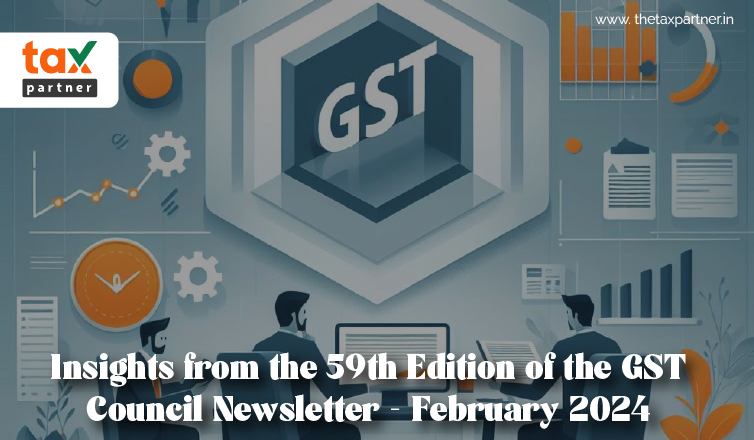Insights from the 59th Edition of the GST Council Newsletter - February 2024
Author- Tanvi Thapliyal
Keeping up with the ever-changing world of taxation is crucial for taxpayers, policymakers, and stakeholders. It's important to stay informed about the latest developments and policy changes. The February 2024 edition of the Goods and Services Tax (GST) Council Newsletter, which is the 59th edition, provides valuable information about the current state of GST in India. As we read through this newsletter, we will learn about the important developments in tax administration, enforcement measures, and infrastructure enhancements that took place during the month. This article aims to summarise the main points of the newsletter, giving readers a thorough understanding of the important developments and trends that are influencing the GST ecosystem. Come join us as we explore the details and significance of the most recent updates in GST for February 2024.
Strong Growth in GST Revenue
The GST revenue collected for February 2024 showed a significant increase, highlighting a strong and resilient economic growth.
-
The latest figures show that GST revenue has grown significantly by 12.5% compared to the same month in 2023. The recent increase in economic activity not only shows that the economy is doing well, but also highlights how effective the GST system is in generating revenue.
-
The increase in GST revenue is a result of several factors that have played a role. The main factor that contributed significantly to the overall growth was the strong increase in domestic transactions, which was highlighted by a significant 13.9% rise in GST collections.
-
There was a notable 8.5% rise in GST revenue generated from the import of goods, which significantly contributed to the overall figures. These factors together show that there is a healthy growth in both domestic and international economic activities.
-
The significant growth in GST revenue suggests that there is a positive trend happening in the overall economy. These factors include increased consumer spending, more commercial activities, and a positive business environment. Furthermore, it highlights how the Indian economy has shown resilience in dealing with challenges and taking advantage of opportunities for growth.
-
The increase in GST revenue not only has economic implications, but also shows that the government's tax reforms and administrative measures are effective. The goal of these reforms is to make tax compliance easier, reduce tax evasion, and promote transparency in how revenue is collected. The substantial increase in revenue clearly shows that these efforts have been successful.
The increase in GST revenue for February 2024 is a positive sign for how the government is managing its finances and allocating resources. The government benefits from a strong revenue base, which helps fund developmental initiatives, infrastructure projects, and welfare programmes that aim to promote inclusive growth and prosperity.
Contributory Factors to Growth in GST Revenue
The strong growth in GST revenue can be attributed to the significant increase in domestic transactions. The fact that GST revenue from domestic transactions has increased by 13.9% indicates that there has been a significant boost in economic activity within the country. The growth we are seeing can be explained by a few different things. One is that consumers are spending more money, which is driving up demand for goods and services. Additionally, businesses are feeling more positive about the economy, which is also contributing to the growth. The increase in economic activity can be attributed to policies that encourage people to spend money and invest in the country. This has created a favourable environment for businesses to grow and improve their operations.
-
One of the reasons for the increase in GST revenue is the significant growth in collections from imported goods, which has seen an 8.5% increase. It seems like there is a positive trend in import activity. This could mean that trade volumes are increasing and there is a higher demand for imported goods.
-
There are a few factors that could have contributed to the growth in imports. One possibility is the recovery in global trade, which means that more goods are being traded between countries. Another factor could be the easing of supply chain disruptions, which means that it's easier for goods to be transported and delivered. Lastly, favourable exchange rates may have also played a role, making it more affordable for businesses to import goods.
The effectiveness of policy measures and administrative reforms implemented by the government played a crucial role in driving the growth in GST revenue. Efforts to make tax compliance easier, reduce tax evasion, and strengthen enforcement methods have helped to collect revenue more efficiently. It's likely that initiatives like implementing e-invoicing, digitizing tax processes, and taking stronger actions against tax evasion have had a positive effect on generating GST revenue.
Financial Year Performance
India's Goods and Services Tax (GST) regime is showing resilience and strength as we progress through the fiscal year 2023-24. The revenue collection has been impressive up until February 2024, indicating the success of the GST system.
-
The total gross GST collection has reached ₹18.40 lakh crore, which is a significant 11.7% increase compared to the previous fiscal year. These figures highlight the strength of the GST system and its crucial role in boosting government revenues.\
-
The most noteworthy achievement of the fiscal year is the total gross GST collection, which has reached ₹18.40 lakh crore by February 2024. This significant increase represents an 11.7% growth when compared to the same period in the previous fiscal year. The increase in revenue collection shows how well the GST system is able to handle changes in the economy.
-
The steady growth trajectory in GST revenue collection throughout the fiscal year shows that the economy is consistently growing and gaining momentum. Although there have been challenges from global uncertainties and domestic factors, the Indian economy has shown resilience. This has led to increased economic activity and higher GST collections. The fact that this steady growth trend continues is a positive sign for the overall financial well-being of the country.
There are several reasons behind the strong growth in GST revenue collection for the fiscal year 2023-24. Some of the things that are being done are improving compliance measures, making tax administration more efficient, implementing policy reforms to boost economic growth, and highlighting the strength of the Indian economy despite difficult situations. The government and tax authorities have worked together to create an environment that supports revenue generation.
Consistent Growth Trend
In the fiscal year 2023-24, the revenue collection from Goods and Services Tax (GST) in India has shown impressive growth and has consistently increased, highlighting the strength and effectiveness of the GST system. One of the main things to note about this fiscal year's performance is that we have seen a consistent growth trend. This is shown by the fact that our average monthly gross collection has exceeded that of the previous fiscal year.
-
There has been a consistent pattern of growth in GST revenue collection on a monthly basis throughout the fiscal year 2023-24. It's been great to see that every month we've been making more money compared to the same months last year. This shows that our GST revenue is consistently growing and doing well.
-
The average monthly gross collection for FY 2023-24 is one of the most notable indicators of this consistent growth trend. The average monthly collection for this fiscal year has exceeded that of the previous fiscal year, indicating a consistent economic growth and higher revenue coming into the government's funds.
-
The fact that the monthly revenue growth is consistent has important implications for fiscal planning and management. It gives policymakers a dependable source of income, which helps them plan and distribute funds for development projects, infrastructure, and social welfare programmes. Furthermore, the ongoing growth trend gives stakeholders, such as investors, businesses, and consumers, a sense of confidence. This indicates that the economy is stable and resilient.
A positive outlook can be seen in the sustained growth trajectory of GST revenue collection for FY 2023-24, which is a good sign for the overall economic outlook of the country. The fact that the GST regime is able to generate revenues and support fiscal stability highlights its strength and adaptability. Furthermore, it helps to build trust among investors, promotes economic development, and enhances India's reputation internationally.
Breakdown of February 2024 Collections
The revenue collection from the Goods and Services Tax (GST) in February 2024 was quite strong, which demonstrates the effectiveness and strength of the taxation system. The breakdown of GST collections for this month gives us an idea of how the revenue is divided among different components. It shows us the contributions of Central Goods and Services Tax (CGST), State Goods and Services Tax (SGST), Integrated Goods and Services Tax (IGST), and Cess.
The Central Goods and Services Tax (CGST) is a tax imposed on the supply of goods and services within a country
-
The total collection is ₹31,785 crore.
-
CGST makes up a large part of the total GST collections, which helps to generate revenue for the central government. The collection in CGST represents the economic activities that fall under the central government's jurisdiction.
The State Goods and Services Tax (SGST) is a tax imposed by the state government on the supply of goods and services within a particular state.
-
The total collection is ₹39,615 crore.
-
SGST revenue refers to the portion of GST that is collected by the state governments and contributes to their overall revenue.
-
The collection of SGST highlights the strong economy and business activities happening at the state level.
The Integrated Goods and Services Tax (IGST) is a tax system that combines both goods and services under one umbrella.
-
The total collection is ₹84,098 crore.
-
IGST is collected on transactions between different states and on imports.
-
The revenue generated from this tax is then divided between the central and state governments.
-
The significant collection of IGST indicates the amount of trade between states and import activities during that time.
Cess
-
The total collection is ₹12,839 crore.
-
Regarding contribution to revenue, cess revenue is allocated for specific purposes, such as compensating states for revenue losses or funding specific projects.
-
The collection in Cess shows that the government is prioritising targeted revenue mobilisation for specific purposes.
The breakdown of GST collections for February 2024 highlights the different ways that revenue is generated within the GST system and the joint efforts of the central and state governments to collect revenue. The collections in CGST, SGST, IGST, and Cess are quite significant, which shows how strong the taxation system is and how important it is in maintaining fiscal stability and promoting economic growth.
Inter-Governmental Settlement
The inter-governmental settlement mechanism is very important because it helps ensure that the revenue from Goods and Services Tax (GST) is distributed fairly between the central and state governments. This helps maintain fiscal autonomy and financial stability at both levels. The Central Government's settlements to the Central Goods and Services Tax (CGST) and State Goods and Services Tax (SGST) from the Integrated Goods and Services Tax (IGST) collected demonstrate a collaborative approach to sharing revenue.
Settlement to CGST
-
The amount transferred is ₹41,856 crore.
-
After the inter-governmental settlement, the Central Government transferred ₹41,856 crore to the CGST from the IGST collected. This allocation represents the portion of GST revenue that is collected on inter-state transactions and imports. It contributes to the central government's overall revenue pool.
Settlement to SGST.
-
The amount transferred is ₹35,953 crore.
-
The Central Government has transferred ₹35,953 crore to the State Goods and Services Tax (SGST) from the Integrated Goods and Services Tax (IGST) that was collected.
The process of inter-governmental settlement ensures that the distribution of GST revenue is fair and transparent, in line with the principles of cooperative federalism. The settlement mechanism allows the central and state governments to meet their financial obligations and fund important public services and development projects by transferring the appropriate shares of IGST collections to both CGST and SGST.
Combatting Fraudulent Activities in GST
The Directorate General of GST Intelligence (DGGI) and the Central Board of Indirect Taxes and Customs (CBIC) have taken steps to prevent fake and fraudulent summons related to Goods and Services Tax (GST) violations. This shows their dedication to maintaining honesty and fairness in the taxation system.
-
DGGI and CBIC have found cases where people with malicious intentions are issuing fake summons to taxpayers, wrongly accusing them of GST violations.
-
These summonses often have Document Identification Numbers (DIN) that look genuine but are not actually issued by DGGI.
-
There are serious consequences for people who commit this wrongdoing. The Directorate General of GST Intelligence (DGGI) is taking strong actions to address this issue.
-
They are filing complaints with the police against those who are responsible for creating and sending fake summonses.
-
The proactive approach is designed to discourage people from participating in fraudulent activities and protect taxpayers from unnecessary legal problems.
-
CBIC has taken steps to inform taxpayers about the importance of verifying the authenticity of communications from tax authorities through circulars and advisories. You should make sure to check if any communication, like a summons, is real by using the online verification tools on CBIC's website.
-
When CBIC officers issue and quote Document Identification Numbers (DIN) on their communications, it helps to authenticate the information. You can check if a communication is legitimate by using the 'VERIFY CBIC DIN' window on the CBIC's website or the DIN Utility Search on the online portal of Directorate of Data Management (DDM), CBIC.
If you receive a suspicious summons about GST violations, it's important to report it right away to the appropriate DGGI/CBIC office for verification.
Improvements made to the GST Portal
The GST portal has recently been updated and improved to provide better services to taxpayers and make processes more efficient.
-
The e-Invoice Master Information Portal has been completely revamped. Portal made some improvements to the e-invoice master information portal in order to make it more user-friendly and improve its overall functionality.
-
These changes were made with the goal of enhancing the user experience. They also added some new features to make it easier for the public to access the e-invoice enablement status.
-
Additionally, efforts are made for exemption lists to be automatically updated and published.
-
Improved the search capabilities to provide a more comprehensive experience.
These features are designed to make things even better for taxpayers. Some of the features they offer are PAN-based search to check the status of e-invoice enablement, automatic publication of exemption lists, a global search bar for easy navigation, improved local search capabilities, daily statistics on Invoice Reference Number (IRN) generation, a dedicated section for mobile app support, and improved accessibility compliance and user interface.
Outreach initiatives
Central GST officers have been organising outreach sessions to educate stakeholders in the Micro, Small, and Medium Enterprises (MSME) sector about different aspects of GST.
-
Central GST officers have organised outreach sessions specifically for the MSME sector.
-
These sessions aim to provide information about recent GST developments, compliance requirements, and government initiatives.
-
These sessions are designed to give MSMEs the knowledge they need about GST regulations, compliance procedures, and the benefits that are available to them.
-
During these outreach sessions, focus is on educating stakeholders about GST implementation, compliance requirements, and initiatives that benefit MSMEs.
Infrastructure development
The government has made significant efforts to develop infrastructure in order to create better working conditions for tax officials.
-
The Revenue Secretary recently conducted a virtual ceremony to lay the foundation stone for the "New GST Bhavan and Residential Quarters, Hyderabad."
-
The government's commitment to modernizing infrastructure for tax officials is highlighted by this project.
-
It involves the construction of the largest office block and tallest structure by the Central Board of Indirect Taxes and Customs (CBIC).
-
The Revenue Secretary highlighted the government's commitment to ensuring that tax officials have comfortable working environments.
-
The new GST Bhavan project is a clear indication of how important the government considers infrastructure to be in order to effectively implement tax policies and administration.
Conclusion
In its 59th issue for February 2024, the Goods and Services Tax (GST) Council Newsletter gives an overview of how GST is changing in India. Every part of the GST system, from policy discussions to enforcement efforts and infrastructure improvements, helps it grow and get better. As different groups of people get used to the new ways that GST compliance and government work, they make the tax system stronger and more useful. Going forward, it will be important to embrace openness, teamwork, and new technologies to make sure that GST continues to be useful and effective in promoting economic growth and compliance.



